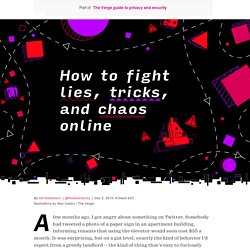

Conspiratorial Thinking. A guide to fighting lies, fake news, and chaos online. AA few months ago, I got angry about something on Twitter.

Somebody had tweeted a photo of a paper sign in an apartment building, informing tenants that using the elevator would soon cost $35 a month. It was surprising, but on a gut level, exactly the kind of behavior I’d expect from a greedy landlord — the kind of thing that’s easy to furiously retweet without thinking. But a little digging showed that the photo was uploaded to Reddit back in 2013, and the post’s author said the signs were quickly taken down. The building manager denied writing them to both the author and a reporter, suggesting that this was either a prank or an immediately abandoned plan. Retweeting the photo would have just outraged people about something that had seemingly never happened.
This kind of viral half-truth is part of the fabric of today’s internet, and the kind of anger it inspired has been turned into a dangerous commodity. I don’t want to blame people who fall for these tricks. Looking Deeper. Real things teachers can do to combat fake news. NewsHour viewers and educators submitted questions on media literacy and fake news.

File photo by REUTERS/Steve Marcus We’ve all picked up a smartphone and clicked on a viral story on social media — or felt overwhelmed and exhausted by an onset of news. A new study shows that in certain circumstances, everyone is susceptible to sharing less-than-truthful online content. So what can you do to combat “fake news”? And how do we help kids get savvy about what they’re reading? You can start by not lumping all dubious content into one category called fake news, says Michelle Ciulla Lipkin, executive director at the National Association for Media Literacy Education (NAMLE). NewsHour viewers and educators submitted questions on media literacy, which we share in short videos in this post, along with additional questions below. Has the rise of the term “fake news” helped or hurt media literacy? Can teachers compete in the era of fake news and alternative facts?
Why was this made? Infographic: Beyond Fake News - 10 Types of Misleading News. The work needed to effectively filter information in our media-saturated environment takes time and skill.

A study showed that the more content we consume, the more our ability to make decisions about its veracity becomes impaired. With 80% of Europeans now regularly going online, it is vital for the sustainable and effective functioning of democracy for citizens to be able to curate their media diets with a healthy critical eye. Our Beyond Fake News infographic identifies the 10 types of potentially misleading news. It was created to be used in class with real-world examples to spark classroom debate and reflection on the ways that media is constructed. We hesitated to put the term ‘fake news’ in the title of the infographic as, ironically, the term itself is a misleading simplification. Below this article, you will find a pdf version of the infographic as well as a dropdown list containing some resources for teaching the 10 Types of Misleading News.
Learning To Spot Fake News: Start With A Gut Check : NPR Ed. Which of these statements seems more trustworthy to you?

1) Americans are drowning in a tsunami of ignorance! There is a conspiracy at the highest levels to replace all knowledge with propaganda and disinformation. 2) A recent Stanford University report found that more than 80 percent of middle schoolers didn't understand that the phrase "sponsored content" meant "advertising. " For most of the NPR audience, this shouldn't be a tough question.
The first sentence is a florid, mislabeled statement of opinion with an unverifiable, overgeneralized, ideological claim ("conspiracy at the highest levels"). The second is more measured in tone and limited in scope. But these days, statements of all stripes are bombarding us via broadcast and social media. And that is the goal of an educational initiative that will be adopted by 10 universities across the country this spring. Thinking like fact-checkers This new approach seeks to get students thinking like, and doing the work of, fact-checkers.